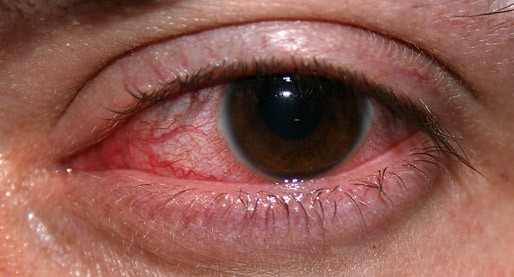Bear in mind that some of the links on this website are affiliate links. If you go through them to make a purchase we will earn a commission at no extra cost to you but helps support our website. Keep in mind that we link these companies and their products because of their quality and not because of the commission we receive from your purchases.
Many of us contact lens wearers have done it before, after all, it is just too easy to lay down and relax after a long day and fall asleep. But is it okay to sleep with your contact lenses in or should you really be trying to make sure you take them off every time you go to sleep?
While there are some contact lenses on the market that are approved to be worn overnight, the vast majority of them are not. Using contacts overnight that is not designed to be done so can lead to serious problems up to permanent vision loss. Even if your contact lenses are approved for extended wear you should still be careful. Take a look below to see why its not really a good idea to sleep with contacts.
Table of Contents
What sleeping with contacts does to your eyes
If you have fallen asleep before with contacts on that you aren’t supposed to fall asleep with, you understand the feeling of trying to get the stuck contact lenses off of your eyeballs when you wake up. I myself have been guilty of this more than a few times.
During the day while you are awake your eyes get oxygen from the air, but while you are sleeping your cornea relies on the blood vessels in your eyelids to supply the oxygen. If you are wearing contact lenses, the contact lens acts as a barrier between your eyelid and your cornea. Which means your cornea is not getting the oxygen it needs while you are sleeping.
The lack of oxygen could cause your cornea to swell up and allow bacteria to get in and develop. According to the Center for Disease Control and Prevention (CDC) says that this bacteria can increase your risk of an eye infection 6 to 8 times.
Risk of sleeping with contacts
Your cornea not getting enough oxygen could lead to some serious conditions, some of which are not reversible and could lead to permanent vision loss. The much-needed oxygen is cut off when you are sleeping with your contact lenses on, and this is what it could lead to.
- Bacterial Keratitis – This is an inflammation that is caused by bacteria and it affects the cornea. Keratitis generally can be treated when attended to promptly but could lead to serious complications and potentially permanent vision loss.
- Corneal Neovascularization – This is a condition that is directly caused by the lack of oxygen to your eye and is an in-growth and invasion of new blood vessels into the cornea. If the blood vessels go too far, this could lead to vision loss.
- Corneal Microscysts – This is another condition that is often found due to the lack of oxygen to your eyes. These microscysts are often found in people using extended wear contact lenses.

- Corneal Ulcer – This is basically an open sore on your eye and can be caused by a severe eye infection. While there are other conditions that could cause corneal ulcers, contact lens wearers are particularly vulnerable to corneal ulcers due to the contact lenses sitting on the cornea. This condition if severe could lead to permanent vision loss.
- Contact Lens Acute Red Eye (CLARE) – This condition is caused by protein deposits or bacteria that has gotten trapped in your contacts and causes the cornea to be inflamed and red.
- Conjunctivitis – This is a fairly common condition in which the conjunctiva is inflamed. You might also know this condition under the name “pink eye”.
If you happen to fall asleep with your contact lens in, it is good to be familiar with the symptoms of an eye infection and go see your doctor right away. Many of these conditions have very similar symptoms and your doctor would have to diagnose to see what is going on. Common symptoms of eye infections include eye redness, light sensitivity, excessive tearing, blurred vision, eye pain, or irritation. If you are experiencing any of these symptoms be sure to contact your eye doctor as soon as you can.
Case Reports from the CDC
The CDC published a study late last year about six different cases where serious corneal infections were associated with individuals sleeping with their contact lenses in.
These patients were evaluated and treated by practicing ophthalmologist in four different major academic medical centers. Take a look below.
- Case 1 – In this case, a man that was 34 years of age with a 17-year history of wearing soft contact lenses was being evaluated for redness in his eyes and blurry vision. The patient reported that he slept in his contact lenses for 3-4 times a week and he occasionally went swimming with his contact lenses in. After a couple of different treatments over the course of 8 months the infection finally resolved.
- Case 2 – For this one, a man that was 59 years of age went on a hunting trip for 2 days and slept in his contacts and developed eye pain on the third day. On the initial evaluation he was diagnosed with a corneal abrasion but while in the shower he wiped his eye with a towel and heard a popping sound and felt pain in his left eye and he was sent to an ophthalmology office where a corneal ulcer was diagnosed requiring an urgent corneal transplant. It wasn’t until a year later after cataract surgery that his vision improved.
- Case 3 – In this situation, a woman that was 34 years of age was evaluated for 3 days of sharp eye pain in her eye. She routinely slept in her contact lenses and used them for longer than the recommended monthly replacement schedule. Evaluation showed an infiltrate which is an acute immune response to corneal damage. She required antibiotic eyedrops as a treatment for the infiltrate.
- Case 4 – For this case, a man that was 57 years of age was in an emergency room with reduced vision and eye pain. He had reported that he slept in his contacts on a regular basis, did not replace them according to schedule, and did not disinfect them daily. He was evaluated and diagnosed with bacterial keratitis in both eyes. A cornal transplant was required to save the right eye and the left eye responded to treatment but left a scar.
- Case 5 – In this case, an adolescent female 17 years of age slept in soft contact lenses and developed a right corneal ulcer as well as a infiltrates. She required multiple antibiotics to treat it and her vision had improved to 20/100 on her follow-up visit.
- Case 6 – Last but not least, in this case, a man that was 18 years of age went to the emergency room reported eye pain, redness, light sensitivity and tearing in his left eye for the past 3 days. He had been wearing decorative soft contact lenses for about a year and routinely slept in his lenses. He was evaluated and diagnosed with an ulcer, edema, and an inflammatory reaction. He was treated with antibiotics and symptoms were better and vision improved, but it did leave a scar behind.
As you can see, sleeping with your contact lenses in is defintely NOT recommended. Even for the contacts that are designed to be worn for extended periods of time should be taken out at least once a week and disinfected. All of the patients in these cases required antibiotic drops for their conditions to improve. These antibiotic drops at times had to be administered hourly and had to be used for weeks or months. And let me tell you, those antibiotic drops are NOT cheap.
Conclusion
So if you accidentally fall asleep with your contact lenses in, just make sure that you are aware of the common symptoms that I had mentioned above. The quicker you realize that you might be getting an eye infection and get to your eye doctor’s office the better.
Thank you for stopping by Eye Health HQ and If you enjoyed the article don’t forget you can support us by sharing this article through your favorite social media channels with the buttons located right below or above this article, I appreciate your support!
